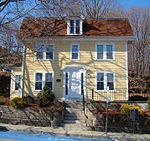Yantic River
AC with 0 elementsConnecticut geography stubsConnecticut placenames of Native American originNortheastern United States river stubsRivers of Connecticut ... and 3 more
Rivers of New London County, ConnecticutTourist attractions in New London County, ConnecticutTributaries of the Thames River (Connecticut)

The Yantic River forms at the confluence of the Deep River, Sherman Brook, and Exeter Brook about 4 miles (6.4 km) east of Colchester, Connecticut. It runs for 14.2 miles (22.9 km) and flows into the Shetucket River in Norwich, forming the Thames River. The Yantic River is a popular whitewater paddling destination with a mix of quickwater and Class I-III whitewater. It passes through the towns of Lebanon, Bozrah, and Norwich. The USS Yantic was named after the river.
Excerpt from the Wikipedia article Yantic River (License: CC BY-SA 3.0, Authors, Images).Yantic River
Chelsea Harbor Drive, Norwich
Geographical coordinates (GPS) Address Website Nearby Places Show on map
Geographical coordinates (GPS)
| Latitude | Longitude |
|---|---|
| N 41.5217 ° | E -72.0787 ° |
Address
Waterfront Public Parking
Chelsea Harbor Drive 105
06360 Norwich
Connecticut, United States
Open on Google Maps











